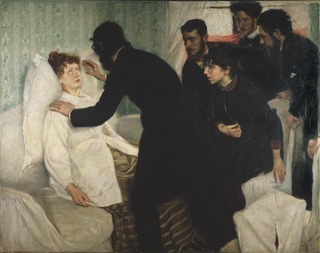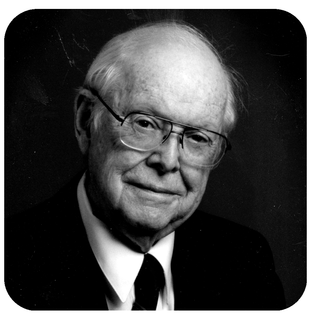
Hypnosis is a human condition involving focused attention, reduced peripheral awareness, and an enhanced capacity to respond to suggestion.
Hypnotherapy is a type of alternative medicine in which hypnosis is used to create a state of focused attention and increased suggestibility during which positive suggestions and guided imagery are used to help individuals deal with a variety of concerns and issues.

Milton Hyland Erickson was an American psychiatrist and psychologist specializing in medical hypnosis and family therapy. He was founding president of the American Society for Clinical Hypnosis and a fellow of the American Psychiatric Association, the American Psychological Association, and the American Psychopathological Association. He is noted for his approach to the unconscious mind as creative and solution-generating. He is also noted for influencing brief therapy, strategic family therapy, family systems therapy, solution focused brief therapy, and neuro-linguistic programming.

James Braid was a Scottish surgeon, natural philosopher, and "gentleman scientist".
Abbé Faria, or Abbé (Abbot) José Custódio de Faria, was a Luso-Goan Catholic monk who was one of the pioneers of the scientific study of hypnotism, following on from the work of Franz Mesmer. Unlike Mesmer, who claimed that hypnosis was mediated by "animal magnetism", Faria understood that it worked purely by the power of suggestion. In the early 19th century, Abbé Faria introduced oriental hypnosis to Paris.
Autosuggestion is a psychological technique related to the placebo effect, developed by apothecary Émile Coué at the beginning of the 20th century. It is a form of self-induced suggestion in which individuals guide their own thoughts, feelings, or behavior. The technique is often used in self-hypnosis.
Self-hypnosis or auto-hypnosis is a form, a process, or the result of a self-induced hypnotic state.
James Esdaile, M.D., E.I.C.S., Bengal (1808–1859), a Scottish surgeon, who served for twenty years with the East India Company, is a notable figure in the history of mesmerism.
The Nancy School was a French hypnosis-centered school of psychotherapy. The origins of the thoughts were brought about by Ambroise-Auguste Liébeault in 1866, in Nancy, France. Through his publications and therapy sessions he was able to gain the attention/support from Hippolyte Bernheim: another Nancy Doctor that further evolved Liébeault's thoughts and practices to form what is known as the Nancy School.
Suggestion is the psychological process by which one person guides the thoughts, feelings, or behavior of another person.

Ormond Dale McGill was a stage hypnotist, magician and instructor who was considered to be the "Dean of American Hypnotists". He was also a writer and author of many books including Hypnotism and Mysticism of India (1979) and The New Encyclopedia of Stage Hypnotism.
The development of concepts, beliefs and practices related to hypnosis and hypnotherapy have been documented since prehistoric to modern times.
Hypnosurgery is a name used for an operation where the patient is sedated using hypnotherapy rather than traditional anaesthetics. It is claimed that hypnosis for anaesthesia has been used since the 1840s where it was pioneered by the surgeon James Braid. There are occasional media reports of surgery being conducted under hypnosis, but since these are not carried out under controlled conditions, nothing can be concluded from them.

Although Amand-Marie-Jacques de Chastenet, Marquis de Puységur (1751–1825) was a French magnetizer aristocrat from one of the most illustrious families of the French nobility, he is now remembered as one of the pre-scientific founders of hypnotism.
For over a century, hypnosis has been a popular theme in fiction – literature, film, and television. It features in movies almost from their inception and more recently has been depicted in television and online media. As Harvard hypnotherapist Deirdre Barrett points out in 'Hypnosis in Popular Media', the vast majority of these depictions are negative stereotypes of either control for criminal profit and murder or as a method of seduction. Others depict hypnosis as all-powerful or even a path to supernatural powers.
Stage hypnosis is hypnosis performed in front of an audience for the purposes of entertainment, usually in a theatre or club. A modern stage hypnosis performance typically delivers a comedic show rather than simply a demonstration to impress an audience with powers of persuasion. Apparent effects of amnesia, mood altering and hallucination may be demonstrated in a normal presentation. Stage hypnosis performances often encourage audience members to look further into the benefits of hypnotism.

Ambroise-Auguste Liébeault (1823-1904) was a French physician and is considered the father of modern hypnotherapy. Ambroise-Auguste Liébeault was born in Favières, a small town in the Lorraine region of France, on September 16, 1823. He completed his medical degree at the University of Strasbourg in 1850, at the age of 26.
Hypnotic induction is the process undertaken by a hypnotist to establish the state or conditions required for hypnosis to occur.

Mark Thomas Gilboyne, nom de guerreGil Boyne, was an American pioneer in modern hypnotherapy.
Animal magnetism, also known as mesmerism, was the name given by German doctor Franz Mesmer in the 18th century to what he believed to be an invisible natural force (Lebensmagnetismus) possessed by all living things, including humans, animals, and vegetables. He believed that the force could have physical effects, including healing, and he tried persistently but without success to achieve scientific recognition of his ideas.






